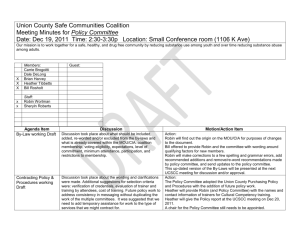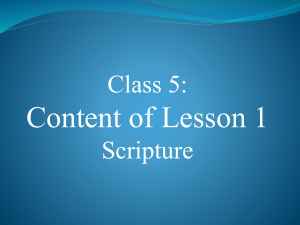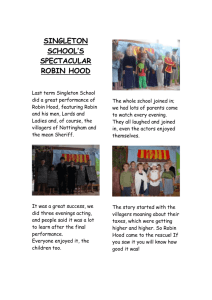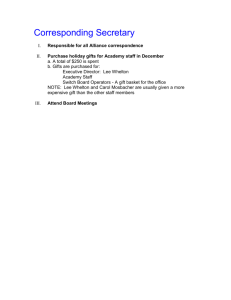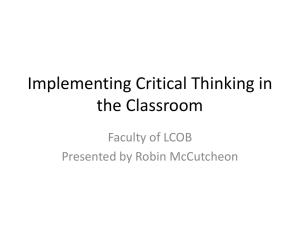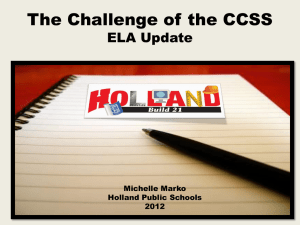Eco-Spirituality - Women Transcending Boundaries
advertisement
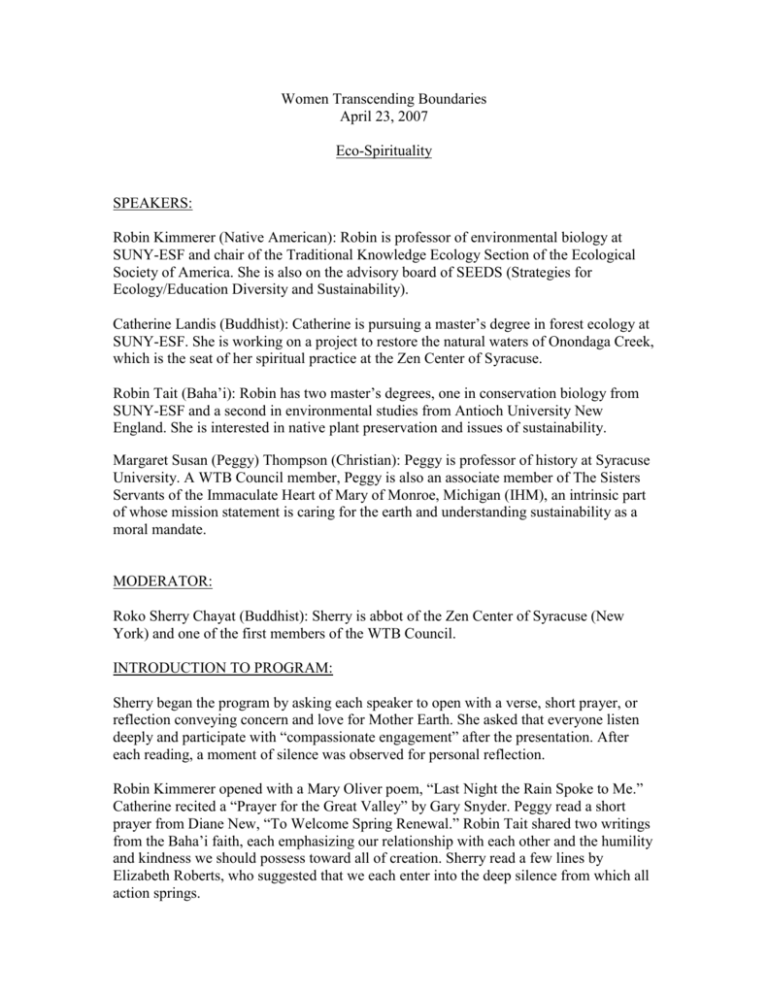
Women Transcending Boundaries April 23, 2007 Eco-Spirituality SPEAKERS: Robin Kimmerer (Native American): Robin is professor of environmental biology at SUNY-ESF and chair of the Traditional Knowledge Ecology Section of the Ecological Society of America. She is also on the advisory board of SEEDS (Strategies for Ecology/Education Diversity and Sustainability). Catherine Landis (Buddhist): Catherine is pursuing a master’s degree in forest ecology at SUNY-ESF. She is working on a project to restore the natural waters of Onondaga Creek, which is the seat of her spiritual practice at the Zen Center of Syracuse. Robin Tait (Baha’i): Robin has two master’s degrees, one in conservation biology from SUNY-ESF and a second in environmental studies from Antioch University New England. She is interested in native plant preservation and issues of sustainability. Margaret Susan (Peggy) Thompson (Christian): Peggy is professor of history at Syracuse University. A WTB Council member, Peggy is also an associate member of The Sisters Servants of the Immaculate Heart of Mary of Monroe, Michigan (IHM), an intrinsic part of whose mission statement is caring for the earth and understanding sustainability as a moral mandate. MODERATOR: Roko Sherry Chayat (Buddhist): Sherry is abbot of the Zen Center of Syracuse (New York) and one of the first members of the WTB Council. INTRODUCTION TO PROGRAM: Sherry began the program by asking each speaker to open with a verse, short prayer, or reflection conveying concern and love for Mother Earth. She asked that everyone listen deeply and participate with “compassionate engagement” after the presentation. After each reading, a moment of silence was observed for personal reflection. Robin Kimmerer opened with a Mary Oliver poem, “Last Night the Rain Spoke to Me.” Catherine recited a “Prayer for the Great Valley” by Gary Snyder. Peggy read a short prayer from Diane New, “To Welcome Spring Renewal.” Robin Tait shared two writings from the Baha’i faith, each emphasizing our relationship with each other and the humility and kindness we should possess toward all of creation. Sherry read a few lines by Elizabeth Roberts, who suggested that we each enter into the deep silence from which all action springs. PRESENTATIONS: Robin Tait (Baha’i): Robin started with a quote from the Baha’i Universal House of Justice: “The oneness of mankind which is at once the operating principle and ultimate goal of revelation (God’s revelation) implies the achievement of a dynamic coherence between the spiritual and practical requirements of life on earth.” Caring for the earth has to be both spiritual and practical. The technologies of today and the future must be formed by our values and spiritual principles. Robin offered some personal thoughts on this: 1. We are here to fall in love with God, with each other, and ultimately with all creation. All of humanity and creation are our family. The knowledge that my family lives downstream, downwind, or downhill from me, and that my waste could injure them, becomes an important awareness in my life. In the Baha’i faith there are two books, the Book of Creation and the Book of Revelation. We need to be reminded of the Book of Creation. 2. We are here to educate. Caring for the earth requires both practical and spiritual education. We all need to acquire at least a basic understanding of how the world works, of food webs, of thermal dynamics, etc. We also need to learn spiritual principles, respect, love, awe, humility, and gratitude. Robin learned these principles through a lot of healing processes. 3. Our values shape our actions with our inner self, others and the earth. Each of us has a capacity for anger and for hurting each other, sometimes emerging from pain and isolation. We must learn compassion. The essence of sustainability is love, community, and compassion. We are here to live as we would have others live. 4. Caring about the earth is about awe and oneness. It’s about looking at the plants and animals as our friends. You love what you know, and you protect what you love. Love is acquired through knowledge. We need also to educate our souls. Biology and creation have to be about awe. One does not have to be religious to be awed by, for example, the flight of a hummingbird across the Gulf of Mexico. Our souls are quickened by beauty. We were given a capacity to love beauty. Robin concluded that love moves the universe, and that ecological sustainability is about sustainable societies. The fundamental principle of unity is based on justice and on institutions in which people—all people—can participate in nonadversarial processes. Peggy Thompson (Christian): Peggy reflected on her weekend with her “mission unit,” a small group of people that is a part of IHM. During this gathering she and others were asked to bring something that reminded them of, or symbolized for them, a wise woman or wisdom figure in their lives. Peggy brought a hazelnut that had been given to her at the funeral of a dear friend and “wise woman” in her life, Rita Mary Broadway. Rita, who died at age 84 in the year 2000, was a sister, a medieval theologian, a scholar, a professor of English, and a mystic in her own right. Much of Sister Rita’s work was based on a 14th-century English mystic known as Julian of Norwich (England). One of Sister Julian’s most famous works was “A Reflection on a Hazelnut.” At Rita’s funeral, a copy of this work was placed on a card, which, along with a hazelnut, was distributed to each person. It reads: “In this little thing [the hazelnut] I saw three truths. The first is that God made it. The second is that God loves it. The third is that God looks after it.” For Peggy this quote reflects how the environment, creation, and her spirituality come together. Spending time feeling good about creation and the environment is all well and good, but action is also required. The community with which Peggy is associated, IHM, does just that. In the year 2000, IHM, at its general assembly, made a corporate commitment that states, “Empowered by the growing realization that we are interconnected with the whole web of life and that escalating violence, increased global poverty, and the exploitation of the earth threaten all of creation, we renew our passion to live the liberating message of Jesus in the spirit of humility, simplicity, and zeal. We choose to in-flesh this calling by working with others to build a culture of peace and to right relationships among ourselves, with the church, and with the whole earth community.” This statement was approved by affirmation. IHM renovated its own physical plant in accordance with its stated values. Even though small in number, increasing in age (the average age of IHM sisters is 69), and possessing no personal wealth, they decided to renovate their whole property (about the size of the Pentagon) in ways that maintain ecological sustainability. The cost was $58 million, which they did not have. However, this was an order formed during the Depression—and they were up to the task. Their success is an example of what a small, committed group can do to benefit a larger community regarding ecological sustainability combined with spiritual values. Catherine Landis (Buddhist): Catherine said that as a student, what informed her ecological awareness was the land itself, learning directly from the land. She had the opportunity awhile ago to work for the forest service in Utah, where she was stationed in a very remote setting of approximately 300,000 acres. Part of her job was to take a map, jump into a truck, and “check out things, find things,” like woodpeckers and Mexican spotted owls, and map their territory. Working alone, she learned how to listen and pay attention to nature and to undo bad habits, like crashing impatiently through the woods. During this time spent alone in nature, she also discovered much about bird calls and learned the language of birds. She became aware of a whole new world. This experience taught her two very important lessons: (1) She was not in charge. She was completely at the mercy of the land. Extending beyond this experience to encompass the whole world, we come to realize, with global warming and other natural phenomena, that we are not in charge. Quoting former SUNY-ESF professor Paul Mannon, “You can’t control tree diseases. The fungi are smarter than us.” (2) We are not alone. While in Utah she became aware of being in a community of sovereign beings. These beings were “people,” just not human people. To her this was not a wilderness but a major metropolitan area. Through this experience, a question arose in her mind: How can there be cultural relationships between humans and other species? Although her work on the Onondaga Creek Project has been a different experience, she recognizes that this area is still an ecosystem, similar in many ways to the remote Utah area. You have water cycling, energy flow, nutrient cycling; only with Onondaga Creek these processes are dysfunctional due to changes made by humans. Relating her Buddhist practice to her relationship with nature, Catherine explained that in Buddhism there is a strong sense of interdependence. Things don’t exist by themselves. Buddhism reflects the ecological web and takes it into a further reality by saying that the pieces are all one. Buddhism also focuses on the individual experience. This awareness in Buddhist practice has enriched her ecological understanding. Things are constantly changing. There is a flow compatible with the evolution of species. Robin Kimmerer (Native American): The holiness of Mother Nature is Robin’s church. Planting peas is an act of worship. The richness of the dirt, and all that live in and on it, represents mutual sustainability. Peas do not plant themselves. They rely on other parts of creation just as all of creation relies on each other. Robin, a member of the Potawatomi Nation, said that some of the teachings of Native Americans are not universal. However, a teaching shared by all the 600 or so different Native American cultures in North America is a mutual respect for the earth and a caring for it. As a scientist Robin is very much influenced by her Native American heritage. The gifts of nature are always a part of her awareness. The definition of a gift is something that just comes to us whether we deserve it or not. When we live on this earth in not such a good way, we are less deserving of these gifts. The earth is incredibly generous and knows no bounds. When we think of the world as a gift we should ask ourselves, a gift from whom? What is the source of this gift? To Robin they are gifts from themselves. They give their gifts directly. In the Native American tradition, all beings are thought of as persons. Nonhuman persons have their own will, their own intentions, and their own history and story. We should always think of these beings as our teachers. As a scientist Robin is aware of the teachers around her in nature. In the native way of thinking, humans are the younger brothers of creation. We know the least about how to live on this earth. Our job is to look to our elders of creation. What is our response to a gift? Should we, or should we not, take care of it? If the gift comes from someone or something we love, the relationship changes. You become grateful and caring. You become bound to the giver. You want to return the gift. When we think of our ecosystem as a gift, then it opens up this culture of gratitude. It also opens up the door to giving back. The idea of gifts and responsibility is at the core of mutually sustaining ourselves and the earth. Gifts and responsibilities are two sides of the same coin. If you are given a gift it becomes your responsibility to use it. This is called our original instructions from the Creator. As Kathy Dean Moore says, “In a world of gifts, how then shall we live?” As humans, one of our gifts is thanksgiving. We know how to be thankful, and it is our job to take care of each other. We should never stand in the way of another being exercising its gift. We must be vigilant in finding our gifts and then use our gifts and dreams for the good of all creation. Questions followed.
